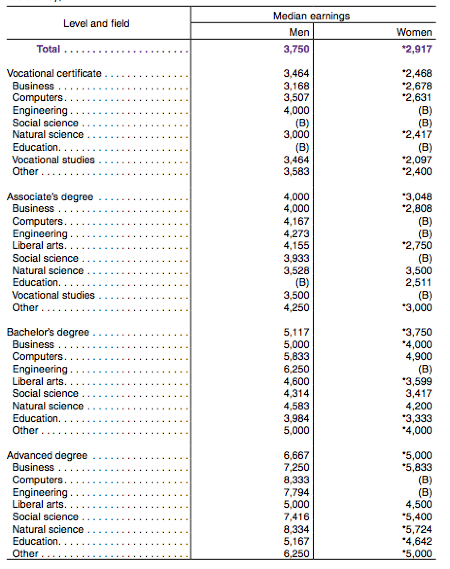Women Make Less Than Men at Every Education Level
March 2, 2012
 From GOOD by Amanda Hess – In every field, at every level of education, men earn more than women. That’s the grim takeaway of this new report [PDF] from the U.S. Census Bureau, which assesses the value of a higher education in the United States—and illustrates the persistent pay gap between male and female employees who hold comparable degrees. In short, education is valuable, but it’s most lucrative if you’re male.
From GOOD by Amanda Hess – In every field, at every level of education, men earn more than women. That’s the grim takeaway of this new report [PDF] from the U.S. Census Bureau, which assesses the value of a higher education in the United States—and illustrates the persistent pay gap between male and female employees who hold comparable degrees. In short, education is valuable, but it’s most lucrative if you’re male.
Among Americans with some form of post-high school education—a vocational, associate’s, bachelor’s, or advanced degree—men make more than $800 above women’s pay every month. And the gap widens as men and women climb educational ranks. Men with bachelor’s degrees in business make $1,000 more each month than their female classmates; among men and women with advanced degrees in business, the gap widens to $1,400 a month. In the natural sciences—the only sector in which men and women earned fairly equal pay at the associate’s and bachelor’s degree levels—the equity was erased among advanced degree holders. Men with advanced degrees in the natural sciences make about $2,600 more per month than their female peers (couldn’t you use an extra $31,200 a year?). Even in sectors traditionally regarded as feminine—education and liberal arts, for example—male earners outstripped female ones.
Women’s educational attainment is sometimes heralded as a signal of their newfound economic dominance over men, particularly in the context of what some have called a “Mancession.” But even in the depths of the recession—these numbers are from a four-month period in 2009—it’s clear that women are forced to seek higher and higher degrees if they hope to match their less-educated male peers in pay. A woman must secure an advanced degree in liberal arts, for example, to earn the same salary as a male peer with just a bachelor’s. According to the Census report, “any overall improvement” in the pay gap “is likely due to [women’s] increased relative levels of educational attainment.” We already knew how persistent the pay gap was, but when we list the numbers side-by-side—for every degree, in every field—the real-world impact hits hard.

